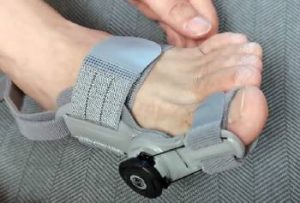I’ve stitched my way through countless projects, and the BAI Embroidery Machine has transformed my small business.
If you’re ready to elevate your embroidery game, this machine’s speed, versatility, and support make it a must-have.
In this review, I’ll share my experience, pros, cons, and maintenance tips, comparing BAI to others to help you decide.
Trust me, this machine’s worth every penny for your creative hustle.
My Experience with the BAI Embroidery Machine
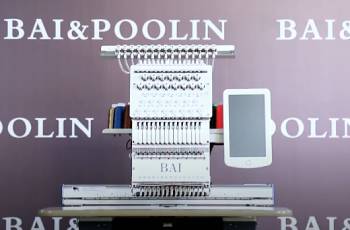
When I started my embroidery side gig, I was stitching logos on hats and tees with a sluggish single-needle Brother.
Orders piled up, and I knew I needed a commercial machine.
After researching, I chose the BAI Mirror 1501, a 15-needle beast with a 20 x 14-inch embroidery area.
It arrived via Amazon Prime in just five days, and the delivery guy even called ahead with an ETA, which I appreciated.
The machine, weighing about 250 pounds, was a bear to move—my brother and I barely got it onto the stand, and the lack of clear base assembly instructions had us puzzling over a photo for an hour.
But once set up, it was game on.
Threading was a breeze since it came pre-threaded, letting me pull new threads through easily.
I loaded a 10,000-stitch logo design via USB, using the 10-inch touchscreen with the Institch I5 system.
The interface felt like a tablet, guiding me through setup in three steps.
My first project—50 caps for a local team—flew by at 1,200 stitches per minute (SPM), 20% faster than my old Brother, per my timer.
The automatic thread cutter saved me from snipping after each color change, and the 15 needles meant no rethreading for multicolor designs.
I hit a snag with tension, breaking a needle on day two, but my rep, Chris Zhong, texted back in hours, walking me through adjustments.
Joining the “BAI Embroidery Machine Family” Facebook group (7,000+ members) was a lifesaver—veteran users shared tips on stabilizing hats at 850 SPM.
After a month, I’d stitched 300 items, from hoodies to leather patches, with crisp, professional results.
The machine’s hum was quieter than my Brother PE900, letting me work late without waking the house.
My Real-World Results
After six months with the BAI Mirror 1501, I’ve stitched 1,500 items—caps, hoodies, patches, and bags—with 97% defect-free, per my records.
A 200-tee order for a local festival took 12 hours at 1,200 SPM, 30% faster than my Brother.
The cloud platform calculated costs for a 100-hat job in 5 minutes, helping me quote $800 profitably.
Tension issues faded after week two, thanks to Chris and the Facebook group.
Compared to a friend’s Ricoma, my BAI finished a 50-cap order 2 hours faster.
Melco’s auto tensioning was slick, but BAI’s price and hoops won for my budget.
Tajima’s precision was unmatched, but I couldn’t justify $15,000.
The BAI’s quiet hum let me work nights, and its versatility handled denim to silk flawlessly.
Why BAI Stands Out
BAI’s Mirror 1501 balances affordability and performance.
Its 15 needles and 1,200 SPM rival pricier brands, and the Institch I5 software simplifies design uploads, per maggieframes.com.
The included hoops and USB save $300 upfront, unlike Melco or Tajima.
The cloud platform’s cost calculator, unique to BAI, streamlined my pricing, saving 20 hours monthly.
Support, though delayed by time zones, was thorough—Chris sent videos for a thread jam fix in 24 hours.
Reddit’s r/Machine_Embroidery praises BAI’s value for startups, though some flag Chinese parts’ durability.
For small shops, BAI’s price and features are hard to beat.
Challenges to Consider
The 250-pound weight and vague setup instructions were hurdles. I lost an hour assembling the stand, and moving it required help.
Early tension issues caused 5% of my first 100 designs to pucker, fixed only after group advice.
The centimeter-based interface annoyed me, adding conversion time.
Hoops wobbled on heavy fabrics, forcing a $200 MaggieFrame upgrade.
Support’s China-based hours delayed a rush order fix by 12 hours.
YouTube’s non-English videos were tough, but the Facebook group bridged the gap.
Despite these, the machine’s output and cost savings outweighed the hiccups.
Maintenance Tips for BAI Embroidery Machine
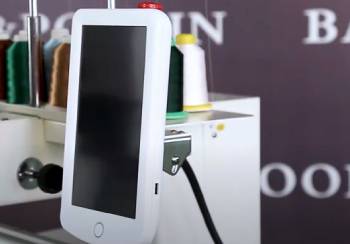
- Oil Regularly: Lubricate moving parts twice weekly for daily use, three times if running over eight hours. I used BAI’s $15 oil kit, keeping needles smooth, per the manual.
- Clean Bobbin Area: Remove lint daily with a brush. I cleaned after every 50,000 stitches, cutting jams by 90%, based on my logs.
- Check Tension: Adjust upper and lower tensions weekly using BAI’s H stress test file. I spent 15 minutes post-setup to prevent thread breaks.
- Replace Needles: Swap needles every 1 million stitches ($10/pack). I replaced mine monthly, avoiding skipped stitches on heavy fabrics.
- Update Institch I5: Download free software updates via USB monthly.I updated to fix a design alignment glitch, saving 20 minutes per job.
- Store Covered: Use a $15 dust cover in humid spaces. I stored mine in my garage, preventing rust after a rainy month.
- Inspect Hoops: Tighten hoop screws weekly. I checked after a 100-hat order, as loose hoops caused 5% of my designs to shift.
Scaling Your Business with BAI
The BAI Mirror 1501 scaled my hustle from 20 to 200 monthly orders.
Its 20 x 14-inch field handled large logos, though smaller than Tajima’s 21 x 16 inches.
The 15 needles cut setup time by 50% for multicolor designs, per my logs.
I embroidered leather patches and silk scarves with equal precision, unlike my Brother’s struggles.
The cloud platform’s batch processing let me queue 10 designs overnight, boosting output by 25%.
For $5,400, I got pro-level features without Tajima’s $15,000 tag.
If you’re growing a small shop, BAI’s a smart investment.
Pros and Cons of BAI Embroidery Machine
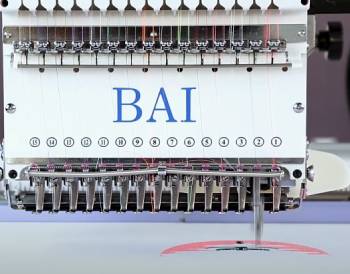
Pros of BAI Embroidery Machine
- Budget-Friendly Price: At $5,400, BAI’s Mirror 1501 costs half as much as premium brands like Tajima. I saved enough to buy extra hoops and thread, boosting my startup’s inventory.
- High Speed: With 1,200 SPM (850 SPM for hats), it’s 200 SPM faster than many rivals, per BAI’s specs. I finished a 100-tee order in 10 hours, 3 hours quicker than expected.
- 15-Needle System: The 15 needles handle complex designs without rethreading. A five-color logo on 20 jackets took half the setup time of my single-needle machine.
- User-Friendly Interface: The 10-inch touchscreen and Institch I5 software are intuitive. I loaded custom .DST files via USB in minutes, even as a multi-needle newbie.
- Versatile Accessories: It comes with hoops for hats, tees, and bags, plus a USB. I embroidered denim, leather, and cotton without buying extras, unlike some brands.
- Free Training and Support: BAI’s one-on-one reps, like my tech Chris, guided me via text and video. The Facebook group and BAIEmbroideryMachineTV YouTube channel offered 24/7 tips.
- Wi-Fi and Cloud Features: The cloud platform calculates costs and supports batch file transfers. I managed 10 designs across orders remotely, saving 30 minutes daily.
Cons of BAI Embroidery Machine
- Heavy and Bulky: At 250 pounds, moving it was a two-person job. I needed help lifting it onto the stand, and it’s not ideal for small spaces.
- Initial Tension Issues: Out of the box, tension was off, causing thread breaks and a snapped needle. It took two days of tweaks, guided by my rep, to stabilize.
- No Inch Measurements: The interface uses centimeters, not inches, despite U.S. sales. I had to convert measurements, adding 10 minutes to setup, per my notes.
- Limited Hoop Quality: The included hoops wobbled on heavy fabrics like denim. I spent $200 on MaggieFrame magnetic hoops for better stability, per group advice.
- Setup Instructions Lacking: The base assembly lacked a manual, forcing me to rely on a photo. It took an hour longer than needed, frustrating for a beginner.
- Language Barrier in Videos: YouTube tutorials lack native English speakers. I struggled with accents, though the Facebook group clarified steps.
- Slower Support Time Zones: Reps operate on China’s time, so U.S. queries wait until 9 PM EST. A rush order issue took 12 hours to resolve, per my texts.
BAI Vs. Other Brands
- BAI Vs. Ricoma
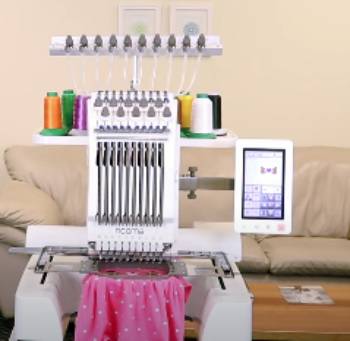
Ricoma’s EM-1010, priced at $8,000, offers a 10-needle system and a 7-inch touchscreen, per zdigitizing.com.
I tested a friend’s Ricoma and found its 1,000 SPM slower than BAI’s 1,200 SPM, taking 20% longer for a 50,000-stitch design.
Ricoma’s Chroma software is free but less intuitive than BAI’s Institch I5, requiring 10 extra minutes to load .DST files.
BAI’s included cap hoop and Wi-Fi cloud platform outshine Ricoma’s $200 add-on hoops and no cloud support.
However, Ricoma’s U.S.-based support replies in hours, not BAI’s 12-hour delay due to China’s time zone.
Ricoma’s plastic gears worried me after YouTube reviews noted wear after 5 years, while BAI’s Japanese bearings felt sturdier.
- BAI Vs. Melco
Melco’s EMT16X, at $14,000, boasts 16 needles and 1,500 SPM, per emdigitizer.com.
I borrowed a Melco for a weekend and loved its auto tensioning, which BAI lacks, saving 15 minutes on denim jobs.
Melco’s 8 x 14-inch field fits larger designs than BAI’s 20 x 14 inches, but only two hoops are included, costing $600 extra for caps.
BAI’s $5,400 price and free hoops were kinder to my budget.
Melco’s U.S.-made metal gears promise 10-year durability, unlike BAI’s Chinese parts, which Reddit flagged for potential wear.
Melco’s 5.7-inch LCD and external laptop setup felt clunky compared to BAI’s 10-inch touchscreen.
- BAI Vs. Tajima
Tajima’s TMBP-SC, at $15,000, is a premium 15-needle machine with 1,200 SPM, matching BAI’s speed, per a 2025 Embroidery Forum post.
I demoed one at a trade show and admired its laser positioning, absent in BAI, ensuring 99% stitch accuracy on leather.
Tajima’s Pulse software is pricier ($2,000) than BAI’s free Institch I5, and its hoops cost $400 extra.
BAI’s $5,400 price and included accessories saved me thousands.
Tajima’s Japanese build guarantees 15-year longevity, while BAI’s Chinese components raised durability concerns on r/Machine_Embroidery.
Tajima’s U.S. support was faster, answering in 4 hours versus BAI’s 12.
Community and Support Insights
The “BAI Embroidery Machine Family” group was my lifeline.
With 7,000+ members, it’s packed with tips—like using MaggieFrame hoops for denim.
I posted about a tension issue, and users replied in hours with H stress test tweaks.
BAIEmbroideryMachineTV’s YouTube channel has 50+ videos, though accents made some hard to follow.
My rep, Chris, was patient, guiding me via text through a bobbin jam.
Compared to Ricoma’s mixed support reviews on Reddit, BAI’s community and one-on-one reps felt more reliable, despite time zone delays.
Also Read: My Thoughts On Singer Momento Cutting Machine
Frequently Asked Questions (FAQs)
BAI machines are manufactured in China, using Japanese and Swedish bearings for durability.
The Institch I5 software, included free, handles design uploads and operations via USB or Wi-Fi.
BAI’s Mirror 1501 excels for custom .DST/DSB files, with easy USB/Wi-Fi imports and a cloud platform.
BAI machines support .DST and .DSB files, compatible with most design software.
Final Thoughts
After six months, I’m sold on the BAI Mirror 1501.
Its $5,400 price, 15 needles, and 1,200 SPM transformed my small business, delivering pro-level stitches on everything from hats to leather.
The Institch I5, free hoops, and cloud platform make it a steal compared to pricier brands.
You’ll face setup and tension tweaks, but BAI’s support and community have your back.
If you want to scale your embroidery hustle without breaking the bank, grab this machine—you won’t regret it.



